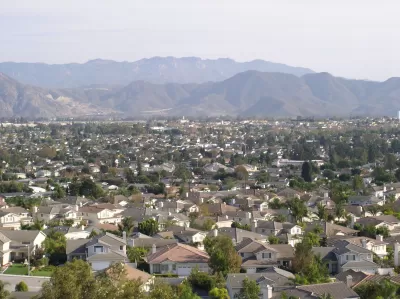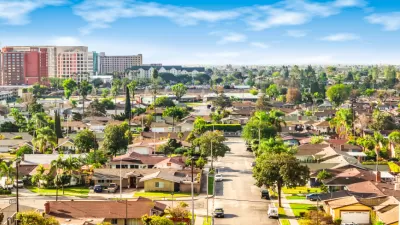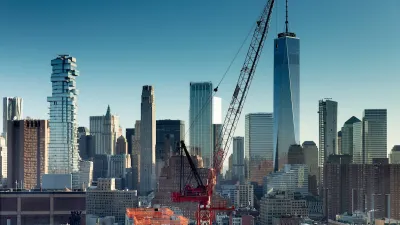While zoning reforms can help reduce barriers to building more housing, high construction costs and local opposition mean that the state won't see an immediate boom in density.

California's Senate Bill 9, recently signed into law by Governor Gavin Newsom, takes aim at the state's housing crunch by abolishing single-family zoning, allowing "owners to split their lots or convert homes to duplexes, regardless of local zoning, in an effort to increase the state’s anemic housing production, open up high-opportunity neighborhoods, and lower rents and home prices."
As Henry Grabar writes, the bill has been praised by opponents of 'exclusionary zoning' as a step toward increasing affordability, and is, symbolically, "a huge deal in the national movement to break down the apartment bans that effectively segregate American cities and shows just how far the policy window has shifted in the past five years." But Grabar argues that "the reality will not be instant housing abundance—or the destruction of the suburbs, for better or for worse." But according to a study from the Terner Center for Housing Innovation, "reforming zoning can only do so much."
The study shows that "SB 9 would be relevant to just 1 in 20 single-family-home parcels in California," partly due to loopholes in the law and and a condition in the bill that stipulates that one owner can't split adjacent lots. "But the largest limitation by far is simply that lightly densifying most parcels won’t pencil: Buying and building in California is expensive. Once you take development costs into account, SB 9’s territory narrows from 6 million to 410,000 parcels." Moreover, "[h]omeowners don’t always act to maximize their financial prospects, and those who try may have trouble securing financing."
Grabar compares SB 9 to California's Accessory Dwelling Unit regulations, which took more than three decades to make a significant impact as "cities and suburbs erected so many regulatory barriers that it was really hard to build a legal ADU." Although today Los Angeles alone is issuing over 5,000 ADU permits a year, "it will take hundreds of years for the state to reach what the Terner Center reckons are the 1.8 million ADUs that could be economically and legally built today."
Grabar foresees similar obstacles for duplexes, such as "height limits, floor-area ratio rules, minimum lot sizes, and development fees," barriers which will likely have to be addressed by the state legislature in the future. According to David Garcia, policy director at the Terner Center, in order to spur construction of ADUs, "[l]awmakers had to be proactive about eliminating setback requirements, reducing impact fees, wiping away owner-occupancy requirements."
While zoning poses one major obstacle to more density, prohibitively high building costs also play an important role. "In much of the state, costs have gotten so high it may take more substantive upzoning to justify buying and demolishing a single-family home." Realistically, says Grabar, single-family neighborhoods "aren’t going anywhere."
FULL STORY: You Can Kill Single-Family Zoning, but You Can’t Kill the Suburbs

Alabama: Trump Terminates Settlements for Black Communities Harmed By Raw Sewage
Trump deemed the landmark civil rights agreement “illegal DEI and environmental justice policy.”

Planetizen Federal Action Tracker
A weekly monitor of how Trump’s orders and actions are impacting planners and planning in America.

The 120 Year Old Tiny Home Villages That Sheltered San Francisco’s Earthquake Refugees
More than a century ago, San Francisco mobilized to house thousands of residents displaced by the 1906 earthquake. Could their strategy offer a model for the present?

In Both Crashes and Crime, Public Transportation is Far Safer than Driving
Contrary to popular assumptions, public transportation has far lower crash and crime rates than automobile travel. For safer communities, improve and encourage transit travel.

Report: Zoning Reforms Should Complement Nashville’s Ambitious Transit Plan
Without reform, restrictive zoning codes will limit the impact of the city’s planned transit expansion and could exclude some of the residents who depend on transit the most.

Judge Orders Release of Frozen IRA, IIJA Funding
The decision is a victory for environmental groups who charged that freezing funds for critical infrastructure and disaster response programs caused “real and irreparable harm” to communities.
Urban Design for Planners 1: Software Tools
This six-course series explores essential urban design concepts using open source software and equips planners with the tools they need to participate fully in the urban design process.
Planning for Universal Design
Learn the tools for implementing Universal Design in planning regulations.
Clanton & Associates, Inc.
Jessamine County Fiscal Court
Institute for Housing and Urban Development Studies (IHS)
City of Grandview
Harvard GSD Executive Education
Toledo-Lucas County Plan Commissions
Salt Lake City
NYU Wagner Graduate School of Public Service





























